I sold
G.V. Desani's All About H. Hatterr to my students as "the Indian
Finnegans Wake." When I said it, I was thinking of the last time I tried to read Desani's novel, early in graduate school. It was a frustrating experience, and more a failure than a success really. Hence, the comparison to the
Wake.
It's odd, because I'm not finding Desani's book even remotely as obscure now. In fact, it's pretty smooth going, and really quite funny.
Here are the
fundae of Desani's life: born and raised in India, moved to England, where he wrote and published
All About H. Hatterr in 1948. It was widely reviewed and even sold a few copies, but Desani never wrote another novel (he did revise and add to the text several times). Between 1950 and 1970 he got seriously interested in various forms of Hindu and Buddhist mysticism, and spent time at Ashrams in India, as well as meditation centers in Burma and Japan. Meanwhile, he was writing occasional columns for
The Illustrated Weekly of India (a magazine that Khushwant Singh would later edit). Desani finally ended up in Texas, where he taught in the English department at UT-Austin (alongside Zulfikar Ghose) until the late 1990s. He passed away in 2001.
(A more detailed bio of Desani can be found at the University of Texas
here)
Salman Rushdie has written in a couple of places about his debt to G.V. Desani's
Hatterr. In the controversial preface to the
Mirrorwork anthology of Indian writing (1997), Rushdie placed Desani at roughly the same rank of importance as R.K. Narayan (the two writers have little else in common). Here is Rushdie:
The writer I have placed alongside Narayan, G.V. Desani, has fallen so far from favour that the extraordinary All About H. Hatterr is presently out of print everywhere, even in India. Milan Kundera once said that all modern literature descends from either Richardson's Clarissa or Sterne's Tristram Shandy, and if Narayan is India's Richardson then Desani is his Shandean other. Hatterr's dazzling, puzzling, leaping prose is the first genuine effort to go beyond the Englishness of the English language. His central figure, 'fifty-fity of the species,' the half-breed as unabashed anti-hero, leaps and capers behind many of the texts in this book. Hard to imagine I. Allan Sealy's Trotter-Nama without Desani. My own writing, too, learned a trick or two from him. (xviii)
Yes, it's true, don't even
try to buy a copy of this novel from Amazon. (I did, a couple of months ago. One of the associated used-book sellers emailed me after a week with an apology: "Actually, we haven't had that in stock for two years. Sorry, we'll give you your money back." I still don't own a copy; I'm teaching it from photocopies.)
One of the reasons many people are afraid of this novel is its reputation for slang-ridden obscurity. Actually, it's not that obscure -- certainly not as difficult as
Ulysses (and not even on the same astral plane as
Finnegans Wake). Moreover, the obscurity is generally literary, not linguistic. In the first 100 or so pages of the novel, I counted a total of ten Hindi words in the text. And most of
those are
'Hobson-Jobson' words like
topi (hat), which would have been readily familiar to readers in 1948. Novels like Manju Kapur's
Difficult Daughters are considerably more dense with Hindustani (or Punjabi) words, and still seem passable enough to western readers.
Anthony Burgess, in his preface to the 1969 edition of the novel, is also careful to disavow the
métèque label that dogged late colonial African writers like
Amos Tutuola. F.W. Bateson coined
Métèque as a way of referring to writers for whom English was a second or third language, who don't respect (or don't know) 'the finer rules of English idiom and grammar'.
It's not that such writing can't produce interesting effects.
But successful forays into slang or, even further, dialect English, are rarely interesting to fluent English speakers unless they are carefully controlled -- by a writer who is quite confident (and of course competent) in the language. The writer may have a memory of learning English, but he or she cannot still be learning English at the time of the writing of the novel. Conrad, Nabokov, and even the contemporary writer Jonathan Safran Foer (
Everything Is Illuminated) knew exactly what they were doing. So did Desani.
The mad English of
All About H. Hatterr is a thoroughly self-conscious and finely controlled performance, as Burgess points out elsewhere in the same preface:
But it is the language that makes the book, a sort of creative chaos that grumbles at the restraining banks. It is what may be termed Whole Language, in which philosophical terms, the colloquialisms of Calcutta and London, Shakespeareian archaisms, bazaar whinings, quack spiels, references to the Hindu pantheon, the jargon of Indian litigation, and shrill babu irritability seethe together. It is not pure English; it is, like the English of Shakespeare, Joyce and Kipling, gloriously impure.
Though Desani doesn't have very much common with Joyce at the level of style, it seems appropriate to read
Hatterr as a species of modernist experimentation.
For one thing, Desani shares Joyce's interest in tweaking the English canon a bit irreverently. Desani's canon is, however, a bit more fringey, having at its center the eighteenth-century classic,
Tristram Shandy (
full text at Gutenberg). There also seems to be the picaresque spirit of Apuleius here; some episodes read a little like they might have come out of
The Golden Ass (
full text at Gutenberg). Third is Lewis Carroll, whose "Mad Hatter" is alluded to in "Hatterr" (it's an amusing exercise to speculate on where the extra 'r' comes from). There are, in fact, dozens of sources in play -- my sharp graduate students spotted references to
Everyman and
Piers Plowman in the first chapter -- but the most prevalent literary reference point by far is
Shakespeare. Some of Desani's Shakespearisms are simple comic misquotations, but others are considerably sustained (if still comically misapplied). One episode that stands out is the opening of "Chapter 1" (which, given the small avalanche of
prolegomena, is by no means the real beginning of the book). It is a kind of remix of
Hamlet. Hatterr, however, is playing the guard:
'All's well, friend Master Keeper o' Literary Conscience!
'The name is H. Hatterr, how d' you do?
'What of that?
'Well, thereby hangs a tale...
'List!'
'List!' is what the ghost in
Hamlet says ("listen!"). Here, however, I think Desani is playing around; "List!" also seems to mean "enumerate!" -- as in, explain yourself, damnit! The odd dialogue (I've quoted only a small part of it) is a kind of framing device for the novel that follows (in which, among other things, Hatterr will explain the origins and significance of his name, and, not coincidentally, offer many lists).
Though all of this playing around
seems quite modernist in shape, early in the novel Desani self-consciously disavows any connection to the Bloomsbury scene (already for the most part dead and, er,
buried by 1948). In the "All About..." section (signed and dated by the author, G.V. Desani), an autobiographical chapter that details the ostensibly 'real' experiences of the author in his quest to get the manuscript of
All About H. Hatterr published, he details one encounter with a
Miss Betty Bloomsbohemia, to whom he addresses the following:
As for the arbitrary choice of words and constructions you mentioned. Not intended by me to invite analysis. They are there because, I think, they are natural to H. Hatterr. But, Madam! Whoever asked a cultivated mind such as yours to submit your intellectual acumen or emotions to this H. Hatterr mind? Suppose you quote me as saying, the book's simple laughing matter? Jot this down, too. I never was involved in the struggle for newer forms of expression, Neo-morality, or any such thing! What do you take me for? A busybody?
In short, Desani is saying, I'm really not trying to do anything fancy with all this Hatterr-speak. And why waste your intellectual acumen with my crazy little book? And no, I'm no modernist, not like you: nothing so
pompous ambitious.
In the midst of this evasive self-acquittal is a seeming grammatical slip: "this book's simple laughing matter." There is apparently a missing indefinite article there ("
a simple laughing matter"). It's possibly an Indianism (intentionally inserted), but the missing "a" makes meaning-making little bit slippery. Most obvious reading is self-deprecation... But perhaps Desani is also playing with the idiom "laughing matter"; it is the "matter" that is "laughing" (at the reader? at Miss Betty Bloomsbohemia?). If this were Joyce, there would also be a joke here about "mater" (Latin: mother), and maybe two or three others. It's not Joyce, but there still might be two or three jokes here, not on mothers, but on naming:
the book's "simple laughing" Hatterr, who is mad as a hatter, never matter the mater.* * * *
Not only is this book out of print,
it's been widely overlooked by scholars of Anglo-Indian literature as well as 20th century literature more broadly. The most ambitious essay I know of is Srinivas Aravamudan's "Postcolonial Affiliations:
Ulysses and
All About H. Hatterr," in the anthology
Transcultural Joyce. It is a witty, learned essay, but it is almost all about... Joyce (surprisingly thin on Desani).
The most
helpful essay on
Hatterr that I know of is M.K. Naik's oddly titled: "The Method in the Madness: All About "All About H. Hatterr" About H. Hatterr." (That's the exact title.) It's from Naik's 1987 survey
Studies in Indian Literature, which is likely to be widely available at decent American university libraries. Naik's essay is especially helpful as a basic, straightforward account of the book: this is what happens, and here is what Desani is trying to do.
I might take a stab at my own essay on Desani at some point soon (hell, given the length of this blog post, I'm already half-way there). But my dream would be to do a
new, fully annotated edition of the text, in the vein of
The Annotated Lolita or
Ulysses Annotated. I somehow doubt it would fly -- hard to imagine the market for an annotated edition of a book that no one knows about!
There is a decently long excerpt from the novel
here.
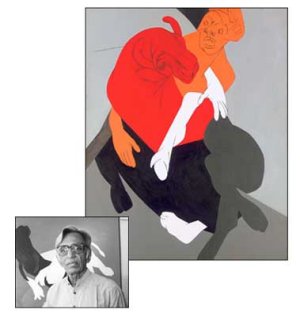
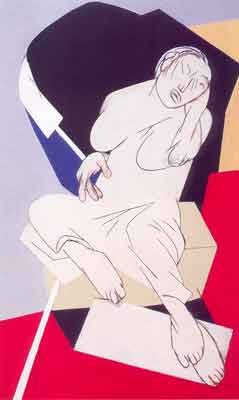

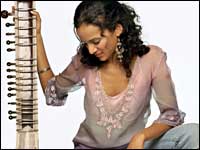
 Last night, we watched the Kevin Spacey film
Last night, we watched the Kevin Spacey film  Darin's singing style wasn't especially original; he became a pop star imitating Elvis Presley, and matured as an artist imitating Frank Sinatra. After he moved away from cheesy rock songs like "Splish Splash," Darin's first jazz/big band hit was the jazz standard "Mack the Knife," a Rat Pack favorite. He just about nails it; in my view, the only version of "Mack the Knife" that's better than Darin's is Louis Armstrong's. (Eartha Kitt, I seem to recall, has a pretty brilliant version as well.)
Darin's singing style wasn't especially original; he became a pop star imitating Elvis Presley, and matured as an artist imitating Frank Sinatra. After he moved away from cheesy rock songs like "Splish Splash," Darin's first jazz/big band hit was the jazz standard "Mack the Knife," a Rat Pack favorite. He just about nails it; in my view, the only version of "Mack the Knife" that's better than Darin's is Louis Armstrong's. (Eartha Kitt, I seem to recall, has a pretty brilliant version as well.)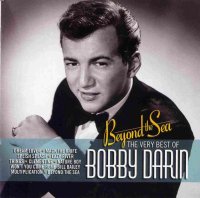 No point recounting the details of Darin's life here (a detailed, if worshipful, bio can be found
No point recounting the details of Darin's life here (a detailed, if worshipful, bio can be found 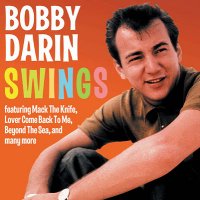 Darin was an Italian from the south Bronx -- his real last name was Cassotto. Beyond the Sea suggests he got the idea for his stage-name when he saw a neon sign above Chinese restaurant: "Mandarin House." The lights for the letters "m" "a" "n" were out, leaving just "Darin." I don't know how true that is.
Darin was an Italian from the south Bronx -- his real last name was Cassotto. Beyond the Sea suggests he got the idea for his stage-name when he saw a neon sign above Chinese restaurant: "Mandarin House." The lights for the letters "m" "a" "n" were out, leaving just "Darin." I don't know how true that is. 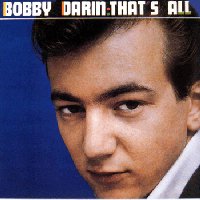 In the later 1960s, when his singing and film careers had essentially fizzled, Darin became an outspoken progressive, and publicly supported Bobby Kennedy in 1968. After Kennedy was assasinated, Darin wrote a protest folk song called "A Simple Song For Peace." It's a little insipid, but aren't all protest songs insipid? (The one exception to the rule might be John Lennon's "Imagine," and even that gets pretty unbearable after a little while.)
In the later 1960s, when his singing and film careers had essentially fizzled, Darin became an outspoken progressive, and publicly supported Bobby Kennedy in 1968. After Kennedy was assasinated, Darin wrote a protest folk song called "A Simple Song For Peace." It's a little insipid, but aren't all protest songs insipid? (The one exception to the rule might be John Lennon's "Imagine," and even that gets pretty unbearable after a little while.) 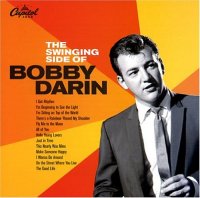 Bobby Darin died of complications from open heart surgery in 1973. He was just 37 -- younger than Shah Rukh Khan, Brad Pitt, or Keanu Reeves at the present moment
Bobby Darin died of complications from open heart surgery in 1973. He was just 37 -- younger than Shah Rukh Khan, Brad Pitt, or Keanu Reeves at the present moment 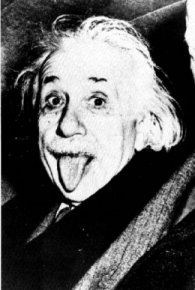 There's a
There's a